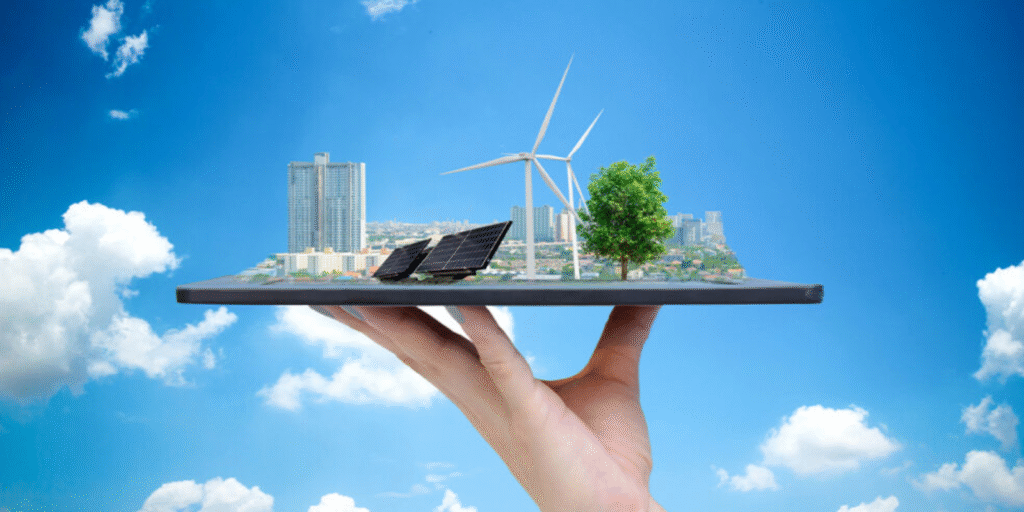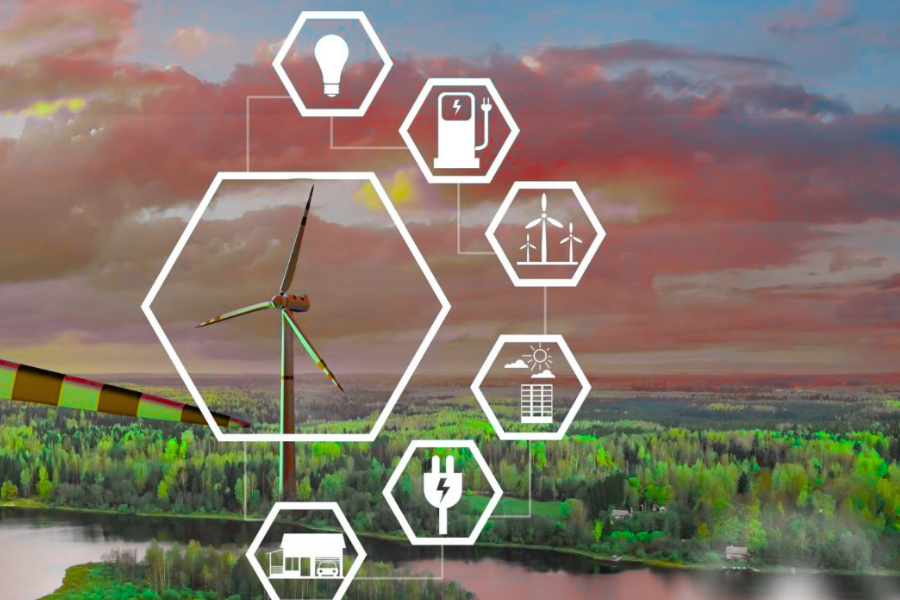Introduction
Green energy is revolutionizing the way we power our world. As concerns about climate change, pollution, and dwindling fossil fuel reserves grow, renewable energy sources are stepping into the spotlight. Solar, wind, hydropower, and other sustainable alternatives are not just environmentally friendly—they are shaping the future of energy.
The transition to renewable energy is no longer a choice but a necessity. Governments, businesses, and individuals worldwide are shifting toward cleaner alternatives, reducing their carbon footprints and promoting sustainability. This movement is not just about energy production but also about long-term environmental conservation, economic stability, and energy efficiency.
Understanding Green Energy
Green energy refers to power generated from natural sources that replenish themselves over time. Unlike fossil fuels, which take millions of years to form and emit harmful pollutants when burned, renewable energy sources harness the power of nature. These include sunlight, wind, water, and even geothermal heat from within the Earth.

The adoption of green energy is driven by two critical factors: environmental responsibility and energy security. Fossil fuels have long been the dominant source of energy, but their impact on air quality, global temperatures, and biodiversity loss is alarming. Green energy, on the other hand, offers a cleaner, more reliable alternative that benefits both people and the planet.
Solar Power: Tapping Into the Sun’s Potential
Solar energy is one of the most widely used renewable energy sources today. By converting sunlight into electricity using photovoltaic (PV) panels, homes and businesses can generate their own power while reducing reliance on traditional energy grids. Advances in solar technology have made panels more efficient and affordable, making it easier for individuals and industries to adopt this clean energy source.
One of the key advantages of solar power is its accessibility. The sun provides an abundant source of energy, and with the right setup, households and companies can harness it efficiently. Many governments offer incentives, rebates, and tax credits to encourage the use of solar panels, making the transition more affordable.
Additionally, solar energy reduces the need for fossil fuels, significantly lowering carbon emissions. It also plays a crucial role in rural and remote areas where electricity grids are weak or nonexistent. With battery storage advancements, solar energy can be used even when the sun isn’t shining, making it a reliable option for sustainable living.
Wind Energy: Harnessing the Power of the Breeze
Wind energy has become a major player in the global renewable energy sector. Wind turbines, placed on land and offshore, generate electricity by capturing the kinetic energy of moving air. This method of energy production has grown rapidly due to technological improvements that have made turbines more efficient and cost-effective.
One of the major benefits of wind power is its scalability. Large wind farms can power entire cities, while small-scale turbines can be installed for individual homes or businesses. Unlike fossil fuels, wind energy does not produce air pollution or greenhouse gases, making it a clean and sustainable alternative.
Despite its benefits, wind energy does come with challenges. The availability of wind is inconsistent, requiring complementary energy sources or storage solutions. Additionally, concerns about the impact of wind farms on wildlife, such as birds and bats, have led to calls for better site planning and innovative designs to minimize ecological disruption.
Hydropower: The Strength of Flowing Water
Hydropower is one of the oldest and most reliable forms of renewable energy. By using the force of moving water to generate electricity, hydropower plants provide a consistent and efficient source of clean energy. Countries with abundant water resources have long relied on this method to supply power to their citizens.
One of the biggest advantages of hydropower is its ability to provide a steady and predictable energy output. Unlike solar and wind energy, which depend on weather conditions, hydroelectric plants can operate 24/7. This makes them an essential component of a stable and balanced energy grid.
However, the construction of large dams for hydropower can have environmental consequences, such as disrupting ecosystems and displacing communities. To address these concerns, newer hydropower projects focus on smaller-scale and run-of-river systems that generate electricity without significantly altering natural water flow.
The Role of Energy Efficiency in Sustainability
While renewable energy sources are critical for reducing dependence on fossil fuels, energy efficiency plays an equally important role in sustainability. Simply generating clean energy is not enough; we must also use it wisely. Energy efficiency measures, such as better insulation, LED lighting, and smart grids, help reduce overall energy consumption, making renewable sources even more effective.
Smart technology is transforming the way we manage energy. From smart thermostats that optimize heating and cooling to energy-efficient appliances that reduce power usage, innovation is making it easier for individuals and businesses to minimize waste. Governments and organizations worldwide are pushing for stricter energy efficiency standards to ensure a sustainable energy future.
Reducing Carbon Footprints Through Green Energy
One of the primary motivations for adopting green energy is the reduction of carbon footprints. A carbon footprint measures the amount of greenhouse gases, particularly carbon dioxide, released into the atmosphere due to human activities. Fossil fuel combustion is a major contributor to carbon emissions, leading to climate change and extreme weather events.
Transitioning to green energy significantly lowers carbon footprints. By replacing coal, oil, and natural gas with renewable sources, we can cut emissions and slow global warming. Additionally, businesses that prioritize sustainability can benefit from a positive brand image, increased customer trust, and even financial incentives.
Individuals can also reduce their carbon footprints by making simple lifestyle changes. Using energy-efficient appliances, driving electric vehicles, and adopting sustainable practices at home can collectively make a big impact. When more people choose clean energy, the demand for fossil fuels decreases, pushing the world closer to a greener future.
Climate Action and the Push for Renewable Energy
The urgency of climate action has never been greater. Scientists warn that without immediate changes, global temperatures will continue to rise, leading to severe consequences such as rising sea levels, habitat loss, and food shortages. Renewable energy is a key solution in the fight against climate change.
Governments worldwide are implementing policies to accelerate the transition to green energy. Many countries have set ambitious goals for carbon neutrality, committing to phasing out fossil fuels and increasing investments in renewables. Financial incentives, carbon pricing, and emissions regulations are driving industries to adopt sustainable energy solutions.
Businesses are also playing a crucial role. Many corporations are setting sustainability targets, investing in green energy projects, and adopting eco-friendly practices to reduce their environmental impact. The shift toward sustainability is not only beneficial for the planet but also a smart business decision as consumers increasingly favor environmentally responsible brands.
The Future of Green Energy
The future of energy is green, and technological advancements continue to drive progress in renewable energy. Innovations in solar panel efficiency, battery storage, and smart grid technology are making clean energy more accessible and reliable. As costs decrease and adoption increases, the transition to a fully sustainable energy system is within reach.
Public awareness and community initiatives are also vital. Educational campaigns, policy advocacy, and grassroots movements are empowering individuals to make informed choices about energy consumption. The push for sustainability is gaining momentum, and collective action can accelerate the shift to renewable energy.
Learn more about: Electrek: The Ultimate Source for EV and Green Tech News
Conclusion
Green energy is no longer just an option—it is the future of global energy production. By embracing renewable sources like solar, wind, and hydropower, we can reduce our dependence on fossil fuels, lower carbon emissions, and create a more sustainable world. The transition to clean energy is crucial in combating climate change, preserving natural resources, and ensuring a stable energy supply for future generations.
As technology advances and costs decrease, green energy is becoming more accessible than ever. Governments, businesses, and individuals all have a role to play in accelerating this transition. Whether through adopting renewable energy, improving energy efficiency, or advocating for sustainable policies, every effort contributes to a cleaner, greener future.
The shift toward green energy is not just about protecting the planet—it’s also about economic growth, job creation, and energy independence. By making informed choices today, we can power a healthier world for tomorrow.
FAQs
1. What is green energy?
Green energy refers to electricity generated from renewable, naturally replenishing sources like sunlight, wind, water, and geothermal heat. Unlike fossil fuels, these sources do not produce harmful emissions, making them environmentally friendly and sustainable.
2. How does green energy help the environment?
Green energy reduces carbon emissions, decreases air and water pollution, and minimizes the impact on ecosystems. By replacing fossil fuels, it helps slow climate change and promotes cleaner air and water.
3. What are the most common types of green energy?
The most popular types include solar power, wind energy, hydropower, geothermal energy, and biomass. Each of these harnesses natural forces to generate electricity without depleting resources or harming the environment.
4. Is green energy expensive?
While the initial investment in green energy solutions like solar panels or wind turbines can be high, the long-term savings on electricity bills and government incentives make it cost-effective. As technology improves, the cost of renewable energy continues to decrease.
5. Can green energy completely replace fossil fuels?
While the transition to 100% renewable energy is challenging, it is possible with continued advancements in energy storage, grid modernization, and policy support. Many countries are already making significant progress toward fully renewable energy systems.
6. How can individuals contribute to the green energy movement?
Individuals can support green energy by using energy-efficient appliances, installing solar panels, reducing energy consumption, and advocating for renewable energy policies. Choosing green energy plans from utility providers is another great way to contribute.
7. What is the future of green energy?
The future of green energy looks promising, with ongoing advancements in technology, increased investments, and global efforts to reduce carbon footprints. As more countries commit to renewable energy goals, green energy will continue to expand and become the dominant source of power worldwide.
